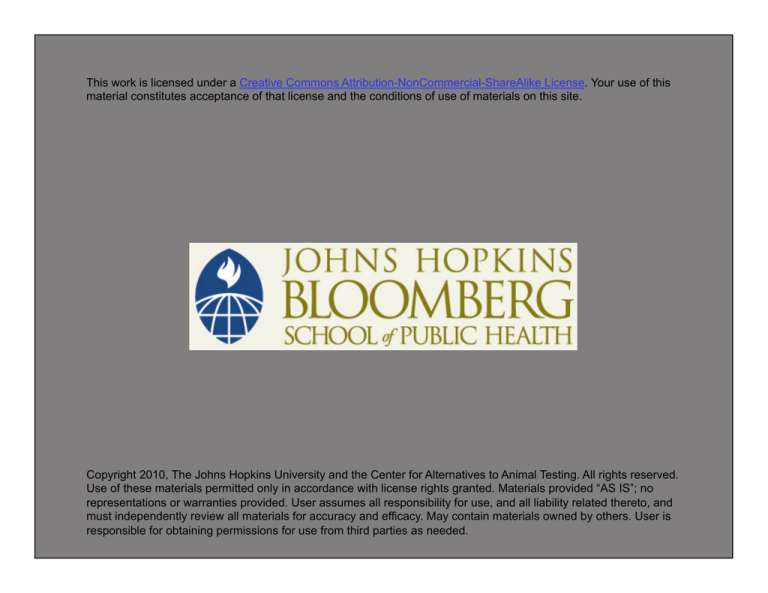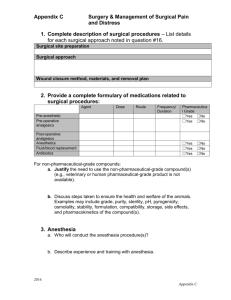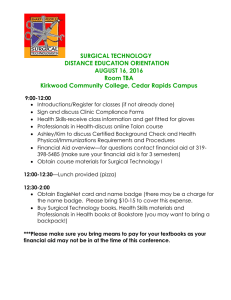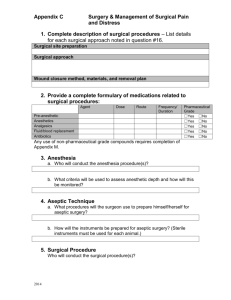
This work is licensed under a Creative Commons Attribution-NonCommercial-ShareAlike License. Your use of this
material constitutes acceptance of that license and the conditions of use of materials on this site.
Copyright 2010, The Johns Hopkins University and the Center for Alternatives to Animal Testing. All rights reserved.
Use of these materials permitted only in accordance with license rights granted. Materials provided “AS IS”; no
representations or warranties provided. User assumes all responsibility for use, and all liability related thereto, and
must independently review all materials for accuracy and efficacy. May contain materials owned by others. User is
responsible for obtaining permissions for use from third parties as needed.
Rodent Surgery
Quality Matters
What’s the Problem?
It’s Just A Rat….
The Classic
Misconceptions
• It’s Just a Rat…
• Anyone Can Do Surgery on Rats
• They are a “lower species” and therefore just a
“replacement” animal
• They’re Tough and They don’t Feel Pain
• and They Don’t Get Infections
The Reality
• Rats can be excellent surgical models
• They are sentient and experience pain and distress
• They are susceptible to post operative infections and
can have can have wound infections, wound
dehiscence, and abscesses the same as all
mammals
• To have good results and outcomes - good surgical
practices are required
Good Surgical
Practices
•
•
•
•
•
•
Surgical Planning
Good Surgical technique
Anesthesia and Physiological Support
Aseptic technique
Post operative analgesia and care
Attention to Detail
Good Surgical
Practices
• Surgical planning
– Learn the anatomy
– Prepare the “operating room”
– Gather all needed instruments, equipment,
supplies and drugs
– Give a pre-operative exam to the animal
(weigh and assess hydration)
Good Surgical
Technique
• Appropriate instruments and proper use
• Gentle handling of tissue
– crushing of tissue
– electro-cautery use
• Keep tissue moist
• Good lighting
– focused
– non-glare
– with minimal heat & drying of tissues
Recommend
Instruments
• Size Fine Surgical Instruments
• #3 handle and use #15 Blades
• Brown-Adsons Tissue Forceps
• Mosquito hemostatic forceps (straight &
curved)
• Small “right angle” forceps
• Adson’s Forceps smooth and rat toothed
Recommend
Instruments (cont.)
• Iris scissors
• Small metzenbaum scissors
• Sharp-Sharp operative scissors
• Ryder needle holders
• Micro-surgery requires micro-instruments
and will need magnification using either
“loupes” or surgical microscope
Good Surgical
Practices
• Anesthesia and Physiological Support
– Replace blood loss and counter-act physiological
hypovolemia with physiological solution (e.g.
lactated Ringer’s) give IV, IP, or SC
– Prevent heat loss and provide heat to maintain
body temperature, 36-37.5!c, during surgery and
recovery
Good Surgical
Practices
• Examples of Anesthesia
– Injection:
• ketamine and acepromazine
• ketamine and xylazine combinations
• pentobarbital
– Inhalation: with oxygen and isoflurane
• entubation is not too difficult and gas anesthetic
machines with mechanical ventilation are available
Good Surgical
Practices
• Aseptic technique
– animal preparation
• clip fur to bare skin (give a border zone of at
least 1-2 cm in all directions from proposed
incision)
• wash skin with disinfectant soap
• rinse well with sterile water or alcohol
• paint with disinfectant solution and allow to dry
(drying time + time for disinfectant to “work”)
Good Surgical
Practices
• Aseptic technique
– Surgeon preparation
• Wear clean clothes (if you have handled other
rats or rodents – change clothes or wear overgowns)
• Wear hair covers and face mask
• Wash hands with disinfectant soap
• Dry with sterile towel
Good Surgical
Practices
• Aseptic technique
– Surgeon preparation continued
• Wear sterile gloves
– Rinse off glove powder using sterile water
before starting surgery (glove powder in
wounds can cause intra-abdominal
adhesions micro-abscesses or granulomas)
Good Surgical
Practices
• Aseptic technique
– Instruments
• Use only sterile instruments
• Best practice is to steam autoclave
• Soaked in cold sterilizing solution(follow
manufacturer’s instructions for required time of immersion and
rinse well with sterile water before using!)
– less desirable
• Soaked in disinfectant (follow manufacturer’s
instructions for required time of immersion and rinse well with
sterile water before using!)
Good Surgical
Practices
• Aseptic technique
– Prepare a Sterile Field
• Secure animal rat to a the “table” or trough
• Cover with sterile drapes in “four corner”
technique or fenestrate a drape to expose only
the prepared skin area
• Lay a sterile drape out for instruments,
sponges, suture etc
Post operative
analgesia and care
• Drugs and dosages appropriate to the demonstrated
pain and distress
• Maintain Body Temperature
– Avoid the use of electrical pads or heat lamps.
– Provide an area for the rat to move away from or
off the heat source.
• Protect eyes with eye ointment (recover on cloth or
paper not cage litter)
• Give antibiotics - if known break in aseptic technique
or if signs of infection (redness, swelling, discharge,
fever)
The “Secrets”of
Good Surgical
Results
• Pay Attention to Detail
• Monitor your patients
• Examine your post op patient often
• If you think something needs to be done
– DO IT
• Quality Matters
References
• Experimental and Surgical Technique in the the Rat,
2nd Edition, 1994, H.B.Wayneforth & P.A.Flecknell
• The Laboratory Rat , 2000, G.J.Krinke
• Ferrets, Rabbits, and Rodents, Clinical Medicine and
Surgery, 1997, E.V.Hillyer & K.E.Quesenberry
• Exotic Animal Formulary, 2nd Edition, 2001, J.W.
Carpenter,T.Y.Mashima & D.J.Rupiper
• Anesthesia and Analgesia in Laboratory Animal,
2002, D.Kohn, S.Wixson, W.White & G.Benson
References
• Clinical Textbook for Veterinary Technicians, 5th
Edition 2002, D.M. McCurnin, J. M. Bassert
THANK YOU
P.R.Brown, DVM, M.Sc.
Department of Comparative Medicine
Center for Alternatives to Animal Testing
Johns Hopkins University
Baltimore, Maryland







